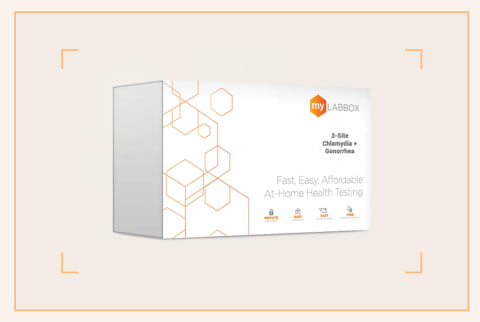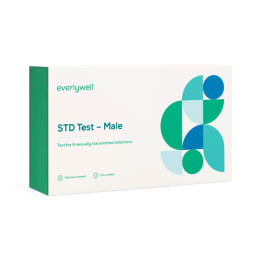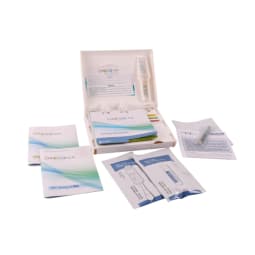Broadly speaking, if detected, STIs are no big deal. All sexually transmitted infections can be cured or treated, after all. “Sexually transmitted infections are only dangerous if you do not know that you have one,” says Emily Rymland, DNP, FNP-C, a doctor of nursing practice, AAHIVS-certified HIV specialist, and director of clinical services at Nurx. Left undetected, sexually transmitted infections can progress into sexually transmitted diseases (STDs), which means they cause unfavorable symptoms and/or other issues. If gonorrhea or chlamydia are left untreated, for example, they can cause pelvic inflammatory disease and infertility, she says, while syphilis can cause dementia, paralysis, and even blindness if left untreated. Thankfully, at-home STI tests make it as easy as ever to find out your current STI status. “At-home STI tests give people the opportunity to learn more about their own bodies and health, right from the comfort of their own home,” says Rymland. Best, they’re usually affordable and nearly foolproof. Read on for a roundup of the best at-home STI tests on the market depending on what you want to get tested for, as well as your gender, sex, sexuality, and budget. These tests are a great option for anyone who doesn’t have time to go to a testing center during the hours their local testing center is open, doesn’t have access to transportation to get to a testing center, or who for their own reasons prefers to avoid doctor office settings, says certified sex therapist Jordan Soper, PsyD., CST. “They also tend to be less expensive than testing at a commercial testing lab or urgent care, making them ideal for people who don’t have health insurance,” adds Rymland. To understand why there might be differences between the different STI tests, you need to understand a bit more about sexually transmitted infections, generally speaking. There are three main types of sexually transmitted infections: Viral STIs (like HIV and herpes), on the other hand, are typically considered full-body pathogens, which means they don’t infect just one body part but instead live in the body. Vital STIs are usually tested for through a blood test, such as a finger prick, though recent innovations may make saliva tests possible, too. Thankfully, Everlywell makes it easy for men and other people with penises to get tested for six common STIs (HIV, gonorrhea, Hepatitis C, chlamydia, syphilis, and trichomoniasis) right from their own home or dorm room. Simply order the Everlywell Male STD Test online, prick and pee in private, ship your samples back in the prepaid discreet packaging, then wait for your results. After your results are viewed by a physician based in your state, they will get delivered to you digitally in a very easy-to-understand spreadsheet. If you do test positive, an Everlywell physician who can prescribe treatment will call you about next steps. The only downside of this option is that if you test positive, you’ll have to take a “test of cure” a few weeks after treatment. This is standard as far as bacterial STIs are concerned, but is a bit of extra hassle when you’re using an at-home—rather than office—test. If you test positive, myLab Box will also suggest you with a physician in your state, but you’ll have to do the legwork to connect with them yourself. Despite what the name implies, this test doesn’t just test for vaginal STIs—it also tests for oral STIs, making it a great option for anyone enjoying barrier-free oral. Best of all, purchase this kit and you’ll get access to the queer-inclusive, trauma-informed Nurx healthcare providers whether you test positive or not. If you test positive, a Nurx provider in your state will prescribe your medication. Very useful! Using this test is easy. Simply swab your cheeks, then wait 20 minutes while your results register. OraQuick has a 24/7 support call center that you can utilize while you wait, or after you receive your result. One thing to keep in mind is that OraQuick is generally regarded as a first-step. If you test positive, you’ll need to go to an in-person lab to confirm (or deny) the results. Similarly, if you test negative but just two weeks have passed since the potential exposure, you’ll need to re-test. The main downside of this option is that the samples must be collected at one of STDCheck.com’s 4500 testing centers, rather than from home. Thankfully, the website says the entire urine and blood collection process takes under 5 minutes. If you’re someone who has a hard time following directions or who is otherwise worried about messing up the self-collection process, this switch is probably a pro. Bonus: Your results are sent to your email as soon as they’re available, which typically takes just 1 to 2 days. Whether you test yourself by going to a doctor’s office or screening yourself from home, however, you need to remember that STIs have an incubation period. When you are first exposed to an STI, it takes time for your body to recognize the infection and create protective antibodies in response to it, explains Soper. The antibodies are what most of these tests are looking for. If you take an at-home STI test before your body has had time to respond to the infection, you will get a false negative. That’s why the National Health Service recommends waiting two to three weeks after a potential exposure to test yourself. Viral STIs like hepatitis, HPV, and HIV can take even longer than that to appear. The best way to ensure accurate results is to test yourself at least two weeks after potential exposure (read: sexy time with someone whose STI status you don’t know or who you know to have a positive STI status) and then again two or three months after exposure. As it goes, most health care professionals think these recommendations are inefficient. “It should go without saying, but men can get STIs and pass those STIs onto their sexual partners, no matter their gender,” says Felice Gersh, M.D., author of PCOS SOS: A Gynecologist’s Lifeline To Naturally Restore Your Rhythms, Hormones, and Happiness. So, what’s a better rule of thumb? Before every new sexual partner, according to Erin Flynn, an NP and health care expert with Favor. “Patients should get checked for STI—either at a clinic or using an at-home test—prior to having sex with a new partner and asking that they do the same,” she says. People should get tested more frequently than that if they begin to experience unusual symptoms. While the majority (nearly 70%) of STIs are asymptomatic, sometimes people will experience STI symptoms, such as pain while peeing, discomfort during sex, itchiness, lumps and bumps, blisters or sores, and unusual discharge. If you experience any of these symptoms, or any other genital, anal, or throat abnormalities, you should test yourself for all STIs. Left untreated, some STIs can have serious consequences such as neurological conditions, infertility, scarring, and more, says Rymland. And of course, left untreated, there is also the risk of transmitting the infection to your other sexual partners, she says. A doctor will be able to help you understand exactly what’s going on with your body and provide the proper treatment or care depending. The following locations often offer low-cost or free STD testing:













